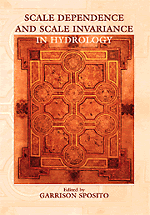Book contents
- Frontmatter
- Contents
- List of Contributors
- Preface
- 1 Scale Analyses for Land-Surface Hydrology
- 2 Hillslopes, Channels, and Landscape Scale
- 3 Scaling in River Networks
- 4 Spatial Variability and Scale Invariance in Hydrologic Regionalization
- 5 An Emerging Technology for Scaling Field Soil-Water Behavior
- 6 Scaling Invariance and the Richards Equation
- 7 Scaling of the Richards Equation and Its Application to Watershed Modeling
- 8 Scale Issues of Heterogeneity in Vadose-Zone Hydrology
- 9 Stochastic Modeling of Scale-dependent Macrodispersion in the Vadose Zone
- 10 Dilution of Nonreactive Solutes in Heterogeneous Porous Media
- 11 Analysis of Scale Effects in Large-Scale Solute-Transport Models
- 12 Scale Effects in Fluid Flow through Fractured Geologic Media
- 13 Correlation, Flow, and Transport in Multiscale Permeability Fields
- 14 Conditional Simulation of Geologic Media with Evolving Scales of Heterogeneity
- Index
14 - Conditional Simulation of Geologic Media with Evolving Scales of Heterogeneity
Published online by Cambridge University Press: 18 January 2010
- Frontmatter
- Contents
- List of Contributors
- Preface
- 1 Scale Analyses for Land-Surface Hydrology
- 2 Hillslopes, Channels, and Landscape Scale
- 3 Scaling in River Networks
- 4 Spatial Variability and Scale Invariance in Hydrologic Regionalization
- 5 An Emerging Technology for Scaling Field Soil-Water Behavior
- 6 Scaling Invariance and the Richards Equation
- 7 Scaling of the Richards Equation and Its Application to Watershed Modeling
- 8 Scale Issues of Heterogeneity in Vadose-Zone Hydrology
- 9 Stochastic Modeling of Scale-dependent Macrodispersion in the Vadose Zone
- 10 Dilution of Nonreactive Solutes in Heterogeneous Porous Media
- 11 Analysis of Scale Effects in Large-Scale Solute-Transport Models
- 12 Scale Effects in Fluid Flow through Fractured Geologic Media
- 13 Correlation, Flow, and Transport in Multiscale Permeability Fields
- 14 Conditional Simulation of Geologic Media with Evolving Scales of Heterogeneity
- Index
Summary
Introduction
Stochastic models are frequently used for analysis of physical phenomena. Many physical and chemical processes in the surface and subsurface environments are controlled by spatially distributed parameters of quite complex and intricate structure. The complexity of the spatial structures, on the one hand, and the limited amount of data usually available for capturing and reconstructing them, on the other, inevitably have led to the use of stochastic techniques, with which the problems of extensive heterogeneity and data scarcity can be treated quantitatively. Stochastic generation of random fields, subject to some a-priori-described spatial laws, is the main vehicle for stochastic modeling. Random-field generation is hardly a new area in stochastic modeling in general, and particularly in geostatistics. Still, in reviewing the state of the art of existing techniques and the conceptual problems that arise as a result (Sposito, Jury, and Gupta, 1986; Dagan, 1994), it is realized that major challenges still remain. First, it seems that even the recent rapid increases in computing power have not kept up with the increasing demand for computing power posed by current-generation techniques. The spatial random-function models in demand for simulation are becoming more and more complex. They are defined by more intricate structures and by many scales of heterogeneity; they are, in general, statistically anisotropic and nonstationary. There is also an increasing demand for three-dimensional simulators. Such specifications can generally be accommodated by very large computing resources, and consequently the popular use of random-field generators has been limited to simple, low-dimension, single-scale, stationary isotropic models.
- Type
- Chapter
- Information
- Scale Dependence and Scale Invariance in Hydrology , pp. 398 - 420Publisher: Cambridge University PressPrint publication year: 1998
- 7
- Cited by



